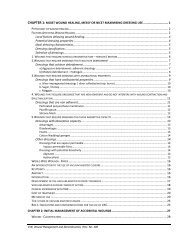permethrin intoxication of cats bibliography - Centre for Veterinary ...
permethrin intoxication of cats bibliography - Centre for Veterinary ...
permethrin intoxication of cats bibliography - Centre for Veterinary ...
Create successful ePaper yourself
Turn your PDF publications into a flip-book with our unique Google optimized e-Paper software.
CITATION YEAR COUNTRY<br />
<strong>of</strong><br />
AUTHOR<br />
Muntener, C. R., L. Bruckner, et al. (2007).<br />
"Declaration <strong>of</strong> suspected adverse reactions <strong>for</strong><br />
veterinary drugs and vaccines in 2005." Schweizer<br />
Archiv Fur Tierheilkunde 149(2): 57-63.<br />
Murphy, M. J. (1994). "Toxin exposures in dogs and<br />
<strong>cats</strong> - pesticides and biotoxins." Journal <strong>of</strong> the<br />
American <strong>Veterinary</strong> Medical Association 205(3):<br />
414-421.<br />
Nebbia, C. (2009). "Pyrethroids are not the most<br />
appropriate remedy <strong>for</strong> tackling fleas and ticks in<br />
<strong>cats</strong>, and may be dangerous <strong>for</strong> fish too." The<br />
<strong>Veterinary</strong> Journal 182(1): 1-2.<br />
Nicholson, S. S. (2000). Toxicology. Textbook <strong>of</strong><br />
<strong>Veterinary</strong> Internal Medicine. Diseases <strong>of</strong> the dog<br />
and cat. S. J. Ettinger and E. C. Feldman.<br />
Philadelphia, W. B. Saunders Company. 1: 357-363.<br />
Page, S. W. (2008). Antiparasitic drugs. Small<br />
Animal Clinical Pharmacology. J. E. Maddison, S. W.<br />
Page and D. B. Church. Edinburgh, Elsevier, Second<br />
Edition: 198-269.<br />
Platt, S. R. and N. J. Olby (2004). Neurological<br />
emergencies. BSAVA manual <strong>of</strong> canine and feline<br />
neurology. S. R. Platt and N. J. Olby. Gloucester,<br />
British Small Animal <strong>Veterinary</strong> Association:<br />
333-335.<br />
Plumb, D. C. (2008). Plumb's veterinary drug<br />
handbook. Sixth edition. Stockholm, Wisconsin,<br />
PharmaVet (Distributed by Blackwell Publishing,<br />
Ames, Iowa).<br />
NOTES<br />
2007 Switzerland We received 105 reports <strong>of</strong> suspected adverse events (SARs) following the use <strong>of</strong><br />
veterinary drugs <strong>for</strong> the year 2005. This corresponds to a 35% increase compared to<br />
2004. Practicing veterinarians sent most <strong>of</strong> these declarations. 73% <strong>of</strong> these concerned<br />
drugs used on companion animals. Antiparasitic drugs approved <strong>for</strong> topical use were<br />
the most frequently represented group with 48%, followed by drugs used to treat<br />
gastrointestinal disorders (11%) and drugs used <strong>of</strong>f label (14%; other target species or<br />
other indication). For the first time 2 declarations concerning the application <strong>of</strong><br />
<strong>permethrin</strong> containing spot-on preparations used by mistake on <strong>cats</strong> were<br />
received. An overview <strong>of</strong> 20 declarations about adverse reactions following application<br />
<strong>of</strong> different vaccines is also presented with emphasis on the problem <strong>of</strong> fibrosarcoma in<br />
<strong>cats</strong>. We are pleased by the growing interest shown by practicing veterinarians <strong>for</strong> the<br />
vigilance system and hope, to further develop this collaboration in the future.<br />
1994 USA Brief mention <strong>of</strong> pyrethrins and pyrethroids as sources <strong>of</strong> <strong>intoxication</strong> in dogs and <strong>cats</strong>.<br />
No mention that cat may be particularly sensitive. Supportive treatment may<br />
include diazepam.<br />
2009 Italy<br />
2000 USA Pyrethrin and pyrethroid insecticides (page 359) "Cats appear to be more<br />
susceptible ot pyrethroid poisoning than dogs."<br />
2008 Australia Permethrin (page 236) "...in contrast to low potential <strong>for</strong> toxicity in most mammals ...<br />
<strong>cats</strong> are very sensitive to <strong>permethrin</strong> ...". Permethrin <strong>intoxication</strong> in <strong>cats</strong> is manifested<br />
principally by hyperexcitability, tremors and seizures. Cats exposed to<br />
high-concentration <strong>permethrin</strong> products with delayed initiation <strong>of</strong> treatment are at<br />
increased risk <strong>of</strong> death.<br />
2004 UK<br />
2008 USA PERMETHRIN Imidacloprid with <strong>permethrin</strong>, topical (Page 1009) The combination<br />
product with <strong>permethrin</strong> (K9 Advantix 8.8% imidacloprid, 44% <strong>permethrin</strong>) must not be<br />
used on <strong>cats</strong>. Use with caution in households ith both dogs and <strong>cats</strong>, particularly if <strong>cats</strong><br />
are in close contact or will groom dogs in the household. Permethrin (Page<br />
PERMETHRIN INTOXICATION OF CATS 28 Novermber 2009 Page 20 <strong>of</strong> 26






